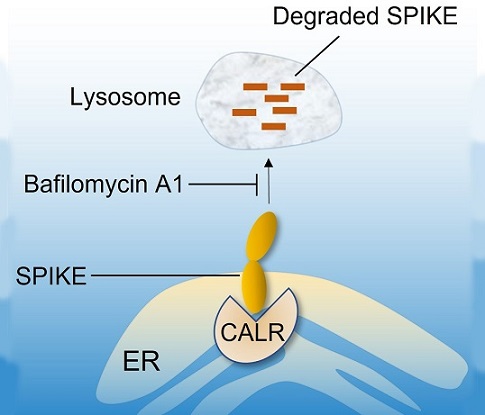COVID-19 News: Boston Study Uncovers Why Cardiovascular Complications Arise In COVID-19 - Calreticulin Plays Key Role In SARS-CoV-2 Infections!
Nikhil Prasad Fact checked by:Thailand Medical News Team Dec 11, 2023 2 years, 1 week, 6 days, 8 hours, 39 minutes ago
COVID-19 News: As the COVID-19 pandemic persists, researchers worldwide are striving to deepen our understanding of the SARS-CoV-2 virus to pave the way for more effective treatments. A recent groundbreaking study conducted at Boston University in the United States has unraveled a novel aspect of the virus's pathogenicity, shedding light on the critical role played by calreticulin (CALR) in SARS-CoV-2 infections. This
COVID-19 News report delves into the comprehensive findings of the study, exploring the intricate molecular dance between the virus and host cells, particularly endothelial cells, and its profound implications for the cardiovascular complications observed in COVID-19 patients.
 Graphical Abstract
Unraveling SARS-CoV-2 Entry Mechanisms
Graphical Abstract
Unraveling SARS-CoV-2 Entry Mechanisms
At the heart of the SARS-CoV-2 infection process lies the interaction between the virus and host cell membranes. The virus utilizes its spike glycoprotein (S protein) to attach to these membranes, a crucial step for successful viral entry into target cells. While angiotensin-converting enzyme 2 (ACE2) is widely recognized as a primary entry receptor, its notably low expression in endothelial cells prompts exploration into alternative mechanisms. The Boston University study provides a breakthrough by revealing that the receptor binding domain (RBD) of the S protein shares structural similarities with the proline-rich binding ena/VASP homology (EVH1) domain, hinting at intricate interactions influencing viral entry.
Calreticulin (CALR) - The Unsung Hero in SARS-CoV-2 Infections
Amidst the complexity of SARS-CoV-2's strategies for cellular invasion, the study identifies calreticulin (CALR) as a previously unrecognized key player. This endoplasmic reticulum (ER) resident protein proves to be an essential mediator in the infectivity of the virus. CALR's interaction with the S-RBD (Spike protein Receptor Binding Domain) through its proline-rich (P) domain emerges as a critical factor in modulating the proteostasis of the S protein, a process vital for the virus's ability to successfully infect host cells.
Regulation of SARS-CoV-2 Spike Protein Turnover
To comprehend CALR's impact on viral dynamics, the researchers employed short hairpin RNA (shRNA) to knock down CALR in human embryonic kidney (HEK-293) cells. The ensuing puromycin pulse-chase experiment revealed a significant increase in the turnover of the SARS-CoV-2 spike protein in CALR-depleted cells. This emphasizes CALR's regulatory role in maintaining the stability of the viral protein. Intriguingly, the study demonstrates that overexpression of CALR rescues the spike protein turnover, suggesting a direct correlation between CALR levels and the fate of the viral protein.
Insights into Proteolytic Pathways
A deeper dive into the cellular machinery involved in regulating t
he S protein reveals a nuanced interplay between CALR and proteolytic pathways. The study demonstrates that lysosomal/autophagy inhibition with bafilomycin 1A selectively increases S protein levels in a CALR-dependent manner. Conversely, the proteasomal inhibitor bortezomib boosts S protein expression independently of CALR. This intricate dance within the endoplasmic reticulum and lysosomal/autophagy pathways sheds light on the multifaceted nature of viral protein regulation.
Implications for SARS-CoV-2 Infectivity and Calcium Homeostasis
Beyond its role in protein turnover, CALR emerges as a central figure in SARS-CoV-2 infectivity. Knocking down CALR in human umbilical vein endothelial (HUVEC-TERT) cells and primary pulmonary microvascular endothelial cells (PMVEC) significantly increases the rate of SARS-CoV-2 infection. This finding suggests that CALR plays a rate-limiting role in determining the infectivity of SARS-CoV-2, particularly in endothelial cells.
The study takes an additional stride by linking CALR to intracellular calcium homeostasis, a critical factor in the pathobiology of COVID-19. As CALR is a major calcium-binding protein, its modulation of intracellular calcium release during SARS-CoV-2 infection becomes a noteworthy aspect of the research. The study reveals that SARS-CoV-2 infection induces a significant increase in intracellular calcium release in cells expressing control shRNA. However, in CALR-depleted cells, this intracellular calcium release is markedly reduced, highlighting CALR's multifunctional role in the context of viral infectivity and host responses.
Discussion
The implications of these findings extend far beyond the laboratory setting. CALR's chaperone function, calcium-binding capabilities, and intricate interaction with the SARS-CoV-2 spike protein contribute to our evolving understanding of COVID-19 pathogenesis. The study prompts questions about the broader implications of CALR's involvement, particularly in endothelial dysfunction and thrombotic events.
Moreover, the study hints at potential connections between CALR mutations and COVID-19 severity, drawing attention to the known association of CALR mutations with various human cancers, such as myeloproliferative neoplasms (MPNs). A recent study suggesting higher risks of arterial thrombosis and death in COVID-19 patients with MPNs adds a layer of complexity to the potential interplay between CALR mutations and COVID-19 outcomes.
Conclusion
In unraveling the molecular intricacies of SARS-CoV-2 infectivity, the Boston University study not only highlights CALR's pivotal role in regulating the spike protein but also opens new avenues for exploration. As the world continues its fight against the pandemic, this research offers hope for improved treatments and a deeper understanding of the complex dance between the virus and host cells. CALR emerges as a key player, and further studies into the biological importance of its interaction with the spike protein could pave the way for targeted antiviral therapeutics. The journey to combatting COVID-19 becomes more nuanced, with CALR at the forefront of the molecular battleground.
The study findings were published in the peer reviewed journal: Cells.
https://www.mdpi.com/2073-4409/12/23/2694
For the latest
COVID-19 News, keep on logging to Thailand Medical News.
